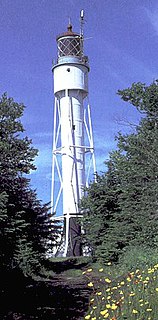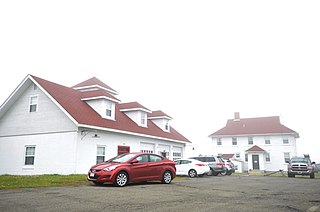
North Manitou Island is located in Lake Michigan, approximately 12 miles (19 km) west-northwest of Leland, Michigan. It is nearly eight miles long and over four miles (6 km) wide, with 20 miles (32 km) of shoreline. It has a land area of 57.876 km2 and has no population. The smaller South Manitou Island lies to its southwest.

South Manitou Island is located in Lake Michigan, approximately 16 miles (26 km) west of Leland, Michigan. It is part of Leelanau County and the Sleeping Bear Dunes National Lakeshore. The uninhabited island is 8.277 sq mi (21.44 km2) in land area and can be accessed by a ferry service from Leland. Guided tours on open-air vehicles are available to visitors, but most traffic is on foot. Larger North Manitou Island lies to its north.

Leland is an unincorporated community and census-designated place (CDP) in the U.S. state of Michigan. As of the 2010 census it had a population of 377. It was the county seat of Leelanau County from 1883 to 2008, when a new government center was completed in Suttons Bay Township, closer to the county's geographic center.
M-209 was a state trunkline highway in the Lower Peninsula of the US state of Michigan. It was located in Leelanau County in the Sleeping Bear Dunes National Lakeshore. Until it was decommissioned, it was Michigan's shortest state highway. M-209 started at M-109 and went just over 1⁄2 mile to Glen Haven. In 1996, M-209's designation was "abandoned", and the road was turned over to the jurisdiction of the Leelanau County Road Commission.

The United States Life-Saving Service was a United States government agency that grew out of private and local humanitarian efforts to save the lives of shipwrecked mariners and passengers. It began in 1848 and ultimately merged with the Revenue Cutter Service to form the United States Coast Guard in 1915.

The Devils Island Lighthouse is a lighthouse located on Devils Island, one of the Apostle Islands, in Lake Superior in Ashland County, Wisconsin, near the city of Bayfield.

The Manitou Island Light Station is a lighthouse located on Manitou Island, off the tip of Michigan's Keweenaw Peninsula in Lake Superior. It was listed on the National Register of Historic Places in 1984.

Point Betsie Light is located on the northeast shore of Lake Michigan — at the southern entrance to the Manitou Passage — north of Frankfort in Benzie County in Northern Michigan. Construction began in 1854, but it was not completed until 1858, and began service in the shipping season of 1859. The lighthouse cost $5,000 to build. In 1875, a life saving station was built for $3,000.

Point Reyes Lifeboat Station, also known as Point Reyes Lifeboat Rescue Station, is a historic coastal rescue station, located on the Drake's Bay side of Point Reyes in northern California, United States. It was built in 1927 by the United States Lifesaving Service to replace a previous station dating from 1888. It is one of the best-preserved rescue stations of that period on the Pacific coast, retaining elements often lost, including the boat launching infrastructure. It is now a historic property managed by the National Park Service as part of Point Reyes National Seashore. It was listed on the National Register of Historic Places in 1985, and it was further declared a National Historic Landmark in 1989.

Glen Haven is a restored port village on the shore of Lake Michigan on the Leelanau Peninsula within the now Sleeping Bear Dunes National Lakeshore. Attractions include the Lake Michigan beach, a restored General Store and Blacksmith Shop. The unincorporated community is located in Glen Arbor Township.

The Bodie Island Lifesaving Station, also known as the Bodie Island Coast Guard Station, is located on the Outer Banks of North Carolina at the southern end of Bodie Island, within Cape Hatteras National Seashore. The 10-acre (4.0 ha) district includes a residence, the lifesaving station, the Coast Guard station, and an observation tower, as well as a number of utility buildings. The facility was turned over to the National Park Service in 1953, with the establishment of the national seashore. The primary structure, the lifesaving station, was built in 1878, and was converted to a residence when the Coast Guard station was built in 1925. It was moved to its present location in 1955, as it was threatened by shoreline erosion. The Coast Guard station was altered the same year to provide housing and office space for the National Park Service.

The Damariscove Lifesaving Station is a historic coastal maritime rescue facility, located on Damariscove Island in Boothbay, Maine. The station was built in 1897, and is one of the more architecturally distinguished of the surviving stations. It was listed on the National Register of Historic Places on June 25, 1987. It is now privately owned.

West Quoddy Lifesaving Station is a historic coastal rescue station on West Quoddy Head in Lubec, Maine. The lifesaving station was built in 1919, and was operated by the United States Coast Guard until 1972. It was listed on the National Register of Historic Places on April 20, 1990. It now houses a bed and breakfast inn.

The Eagle Harbor Coast Guard Station Boathouse is a boathouse located at 9282 Marina Road in Eagle Harbor, Michigan. It was listed on the National Register of Historic Places in 2012.

The North Manitou Shoal Light, also known as the North Manitou Light or, locally, The Crib, is a lighthouse located in Lake Michigan, southeast of North Manitou Island in Leland Township, Michigan. When it was automated in 1980, it was the last manned offshore light in the Great Lakes. It was listed on the National Register of Historic Places in 2005.

The Sleeping Bear Point Life Saving Station, also known as the Glen Haven Coast Guard Station, is a Coast Guard station located near Glen Haven, Michigan. It is significant as a nearly intact version of what was, when built, a prototype architectural design. It was listed on the National Register of Historic Places in 1979, and is now the Sleeping Bear Point Coast Guard Station Maritime Museum and part of the Sleeping Bear Dunes National Lakeshore.

Oregon Inlet Station is a historic lifesaving station located near Rodanthe, Dare County, North Carolina. It was built in 1897 by the United States Life-Saving Service and remodeled in 1933 and 1970. It is a 1 1/2-story, Shingle Style rectangular frame building with a lookout tower. It has a porch that surrounds the building. It was one of seven lifesaving stations established on the Outer Banks of North Carolina in 1874, to serve the ships that were lost in the treacherous waters off the North Carolina coast.

The Whitehead Lifesaving Station was a maritime rescue facility on Whitehead Island, an island off the coast of St. George, Maine at the mouth of Penobscot Bay. Established in 1874 by the United States Life-Saving Service, its original building is one of the best-preserved of the five stations built by the service on the coast of Maine and New Hampshire at that time. The station was in active use until the 1940s, and is now privately owned. It was listed on the National Register of Historic Places in 1988.

The Ocean City Life-Saving Station is the only life-saving station of its design in New Jersey still in existence. Designed by architect James Lake Parkinson in a Carpenter Gothic style, the building is one of 25 stations built of the 1882 life-saving type. It is also one of six still in existence in the country. Construction on the facility began in September 1885 and was completed in the following year. There were two earlier stations in the northern end of Ocean City before this facility was constructed, and there were two stations farther south on the island.























